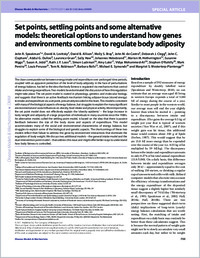Set points, settling points and some alternative models: theoretical options to understand how genes and environments combine to regulate body adiposity
- Speakman, John R. Institute of Biological and Environmental Sciences (IBES), University of Aberdeen, Scotland, UK
- Levitsky, David A. Division of Nutritional Sciences and the Department of Psychology, Cornell University, Ithaca, USA
- Allison, David B. Office of Energetics, Ryals Public Health Building University of Alabama at Birmingham, USA
- Bray, Molly S. Heflin Center for Genomic Sciences Illumina Core Lab, University of Alabama at Birmingham, USA
- Castro, John M. de College of Humanities and Social Sciences, Sam Houston State University, Huntsville, USA
- Clegg, Deborah J. Touchstone Diabetes Research Center, Department of Internal Medicine, Dallas, USA
- Clapham, John C. Research and Development (CVGI), AstraZeneca, Alderley Park, Cheshire, UK
- Dulloo, Abdul G. Department of Medicine/Physiology, University of Fribourg, Switzerland
- Gruer, Laurence NHS Health Scotland, Glasgow, UK
- Haw, Sally Centre for Public Health and Population Health Research, School of Nursing, Midwifery and Health, University of Stirling, UK
- Hebebrand, Johannes Department of Child and Adolescent Psychiatry, University Duisburg-Essen, Germany
- Hetherington, Marion M. Institute of Psychological Sciences, University of Leeds, Leeds, UK
- Higgs, Susanne School of Psychology, University of Birmingham, Edgbaston, Birmingham, UK
- Jebb, Susan A. MRC Human Nutrition Research, Cambridge, UK
- Loos, Ruth J. F. MRC Epidemiology Unit, Addenbrooke’s Hospital, Cambridge, UK
- Luckman, Simon Faculty of Life Sciences, University of Manchester, UK
- Luke, Amy Department of Preventive Medicine and Epidemiology, Loyola University Chicago, USA
- Mohammed-Ali, Vidya University College London Division of Medicine, London, UK
- O’Rahilly, Stephen University of Cambridge Metabolic Research Laboratories, Institute of Metabolic Science, Cambridge, UK
- Pereira, Mark Division of Epidemiology and Community Health, University of Minnesota, Minneapolis, USA
- Perusse, Louis Division of Kinesiology, Department of Preventive Medicine, Laval University, Sainte-Foy, Quebec, Canada
- Robinson, Tom N. Lucile Packard Children’s Hospital, Stanford University School of Medicine, Palo Alto, USA
- Rolls, Barbara Department of Nutritional Sciences, The Pennsylvania State University, University Park, USA
- Symonds, Michael E. Early Life Nutrition Research Unit, Academic Division of Child Health, School of Clinical Sciences, University Hospital, Nottingham, UK
- Westerterp-Plantenga, Margriet S. Department of Human Biology, Nutrim, FHML, MUMC, Maastricht University, The Netherlands
-
2011
Published in:
- Disease Models & Mechanisms. - 2011, vol. 4, p. 733-745
English
The close correspondence between energy intake and expenditure over prolonged time periods, coupled with an apparent protection of the level of body adiposity in the face of perturbations of energy balance, has led to the idea that body fatness is regulated via mechanisms that control intake and energy expenditure. Two models have dominated the discussion of how this regulation might take place. The set point model is rooted in physiology, genetics and molecular biology, and suggests that there is an active feedback mechanism linking adipose tissue (stored energy) to intake and expenditure via a set point, presumably encoded in the brain. This model is consistent with many of the biological aspects of energy balance, but struggles to explain the many significant environmental and social influences on obesity, food intake and physical activity. More importantly, the set point model does not effectively explain the ‘obesity epidemic’ – the large increase in body weight and adiposity of a large proportion of individuals in many countries since the 1980s. An alternative model, called the settling point model, is based on the idea that there is passive feedback between the size of the body stores and aspects of expenditure. This model accommodates many of the social and environmental characteristics of energy balance, but struggles to explain some of the biological and genetic aspects. The shortcomings of these two models reflect their failure to address the gene-by-environment interactions that dominate the regulation of body weight. We discuss two additional models – the general intake model and the dual intervention point model – that address this issue and might offer better ways to understand how body fatness is controlled. This paper was written as a direct consequence of discussions held at The Company of Biologists workshop entitled “Obesity: the gene-by-environment interaction”, organised by John Speakman and held at Melville Castle in Edinburgh, Scotland in May 2010. All the authors were attendees of the workshop and contributed to this manuscript.
- Faculty
- Faculté des sciences et de médecine
- Department
- Département de Médecine
- Language
-
- English
- Classification
- Biological sciences
- License
-
License undefined
- Identifiers
-
- RERO DOC 28354
- DOI 10.1242/dmm.008698
- Persistent URL
- https://folia.unifr.ch/unifr/documents/302250
Statistics
Document views: 192
File downloads:
- pdf: 188
